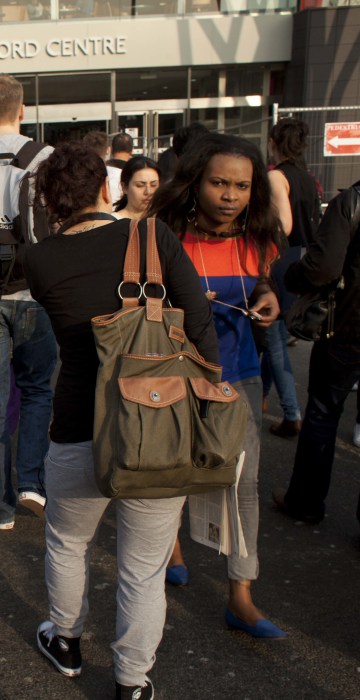
Sports
When the Olympics is your neighbor

Msnbc.com's Marian Smith reports: As the 2012 Olympic and Paralympic Games fast approach, photographer Gideon Mendel seeks to capture the diversity of life within one mile of the main Olympic site. Himself an East London resident, Mendel says he is struck by how many different people from different parts of the world live and work in the area – and is intrigued by the idea that the international participants in this summer’s games will be greeted by such an international community.
This busy intersection in the center of Stratford in the East London borough of Newham shows one slice of the neighborhood that is home to the Olympic stadium and park. This particular crosswalk is significant because it links the old Stratford Center shopping mall, filled with low-end shops and budget grocery stores, with the new Westfield Stratford City shopping center, packed with stores like Armani, Mulberry and Prada. The new mall is the largest urban shopping center in Europe.
Newham is London’s poorest borough and the second-most deprived council area in England, according to the council’s statistics. It is also one of the most ethnically diverse places in Britain, with more than 200 languages and dialects spoken. Algerian restaurants, Polish bakeries, Nigerian textile shops and traditional English greasy spoons sit elbow-to-elbow along Newham’s overflowing streets.
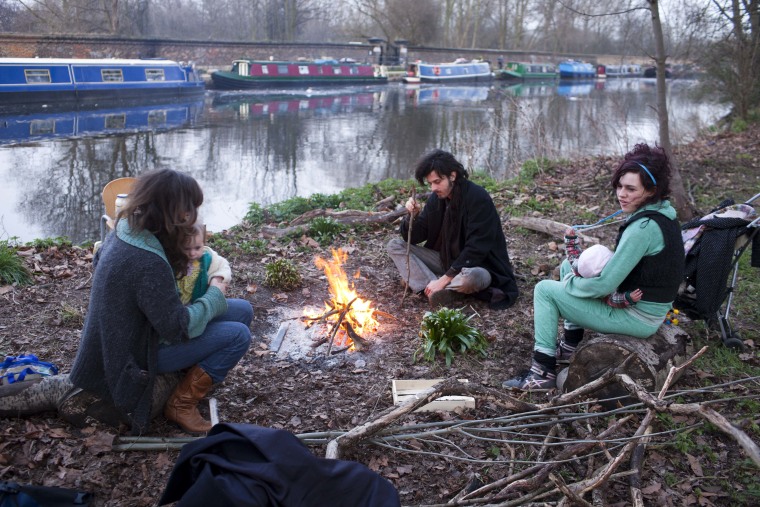
Some members of the houseboat community on the River Lee enjoy a fire on a chilly spring evening. There is a long tradition of people living along the river and surrounding canals, but life has changed recently for the “constant cruisers,” who pay for a yearly license but not for a permanent mooring, which means they must move every two weeks. Dredging and cleanup operations around the Olympic sites have forced many of them to move far away from their usual haunts; this summer the canals around the main sites will be closed off completely. The canals in central London will be under other restrictions – cruisers will have to pay up to 350 pounds ($550) per week to moor along their banks.
The canals were primarily built during the 19th century to accommodate Britain's rapid industrialization and manufacturing boom. Because London's factories and warehouses were clustered in East London, there are far more canals in that part of the city – and therefore around the Olympic sites. Houseboat-dwellers, an eccentric and endearing fixture in London, complain about having to travel too far from their jobs and their children’s schools in order to continue mooring for free. “Exoticism doesn’t really fit into a large-scale military operation,” says Tina Weidner, who has lived on a houseboat in London for three years. British Waterways, which is responsible for managing 2,000 miles of inland waterways, denies that it is “cleaning people out” for the Olympics. “[That criticism] is a bit unfair because we’re trying to work within quite tight security requirements,” says spokeswoman Fran Read. “We think the boats and waterways are incredibly valuable.”
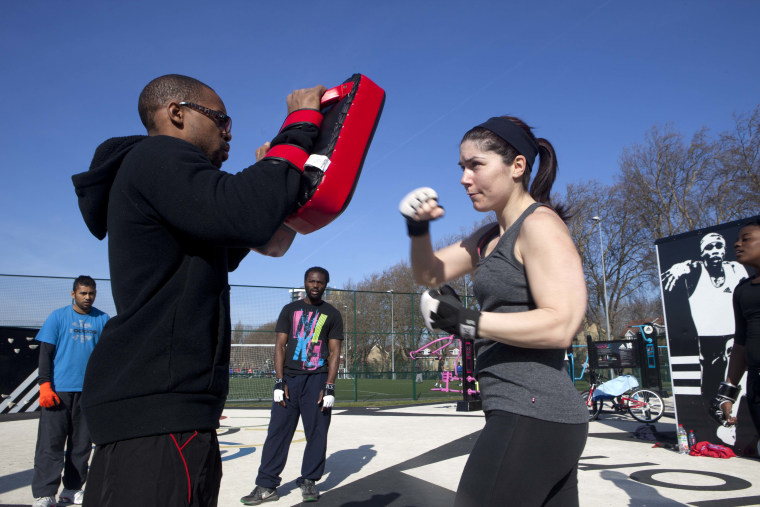
Members of the Street Gym Elites exercise club work out in a newly constructed outdoor exercise area in Mabley Green, Hackney. This area, funded by Olympic sponsor Adidas, is one of the ‘adiZones’, a number of which have been built in the so-called Olympic boroughs – Barking & Dagenham, Greenwich, Hackney, Newham Tower Hamlets and Waltham Forest. These are permanent installations with sporting facilities inspired by Olympic and Paralympic sports that include a basketball, soccer and tennis area, a climbing wall, an outdoor gym and an open area to encourage dance, aerobics and gymnastics.
Mikey Warner, seen at left, who has been leading outdoor training sessions around East London for 20 years, acknowledges that the new park facility is well-equipped and is one of many improvements in the area, but he’s quick to remind people that he has done the Street Gym sports program “off my own back.” He believes kids in the surrounding rough neighborhoods will stay out of trouble if they get involved in sports. “Athletes never get mixed up in that scene,” he says.
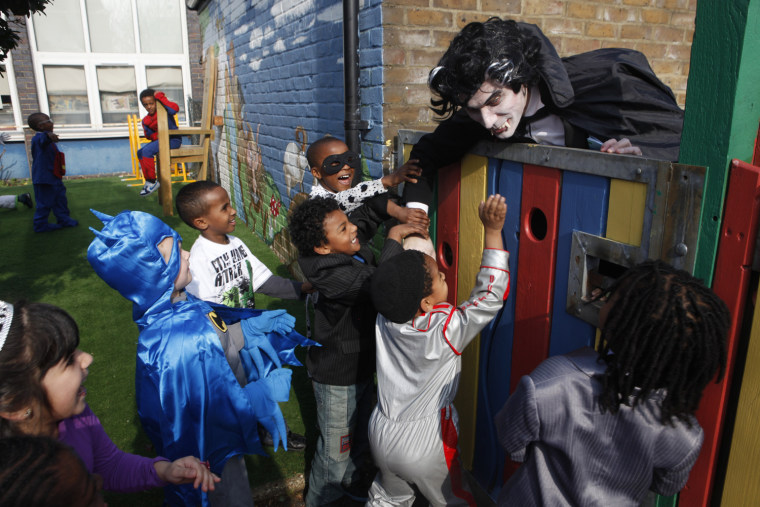
A teacher dressed as Dracula playfully scares some of his pupils at Kingsmead Primary School in Hackney on World Book Day, when the children were asked to come to school dressed as their favorite character from a book or comic. The students are looking forward to the Olympics, though mainly “to see who wins” more than for any other reason, one child says. They elected two of their peers to be “Olympic ambassadors,” who have attended opening ceremonies for some of the venues and who regularly go to meetings about the 2012 games and report back.
According to government data, Kingsmead children are among the most economically deprived in the U.K. – more than half of students are on a free school meals program. In the front entrance a world map covers one wall, dotted with flags representing the children’s families’ home countries. School officials say 95 percent of their pupils are an ethnic minority and they speak 46 different languages – 80 percent speak English as a second language. Despite these challenges, academic achievement is above the national average. The school also recently won an award for Creative School of the Year for the London borough of Hackney.

Visitors on a tour of the Olympic sites head toward the London 2012 Olympic stadium, which will hold 80,000 people this summer. Olympics organizers tout its environmentally friendly credentials – it has been built with lightweight steel and low-carbonate concrete, which is made up of recycled industrial waste. After the games, 55,000 seats will be removed and it will be used for a variety of athletic and cultural events.
To the right is the ArcelorMittal Orbit tower, designed by renowned British-Indian artist Amish Kapoor. It has been both lauded and viciously criticized by artists in the local area. Admirers are quick to point out that many people in France hated the Eiffel Tower when it was first built and now it is the icon of Paris.
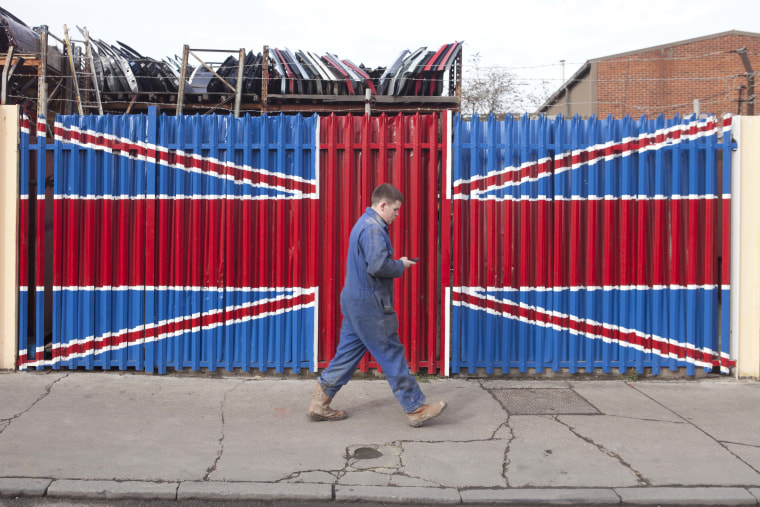
A local worker walks past the well-known Union Jack Gates in Hackney Wick outside a scrap yard and car repair workshop, close to the main Olympic site. The immediate area is a mix of scrap heaps, builders’ yards and old warehouses converted into artist’s studios. The area has an active artistic community and was once the largest concentration of manufacturing in the country.
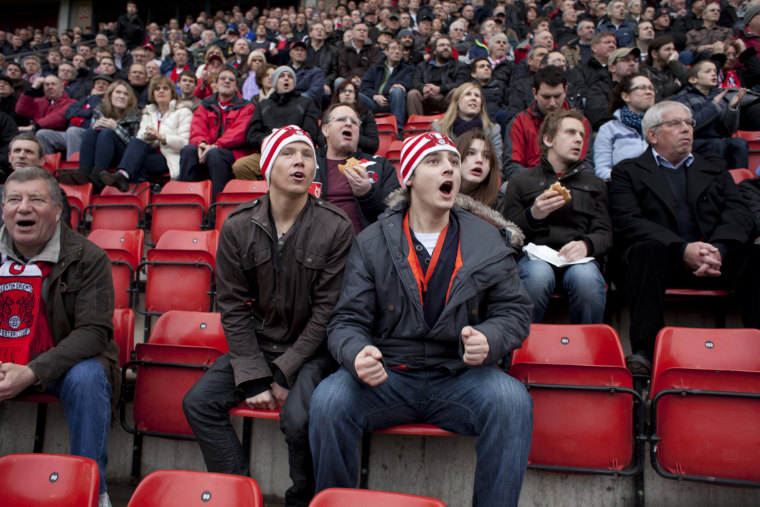
A moment of excitement for Leyton Orient soccer fans as their team comes close to scoring a goal during a home game at the Matchroom stadium close to the main Olympic site. Leyton Orient is a professional team that plays in Football League One (effectively the third division). They are known to their fans as the O’s.
Story: Brits revel in gloom ahead of London Olympics, but don’t believe the gripe
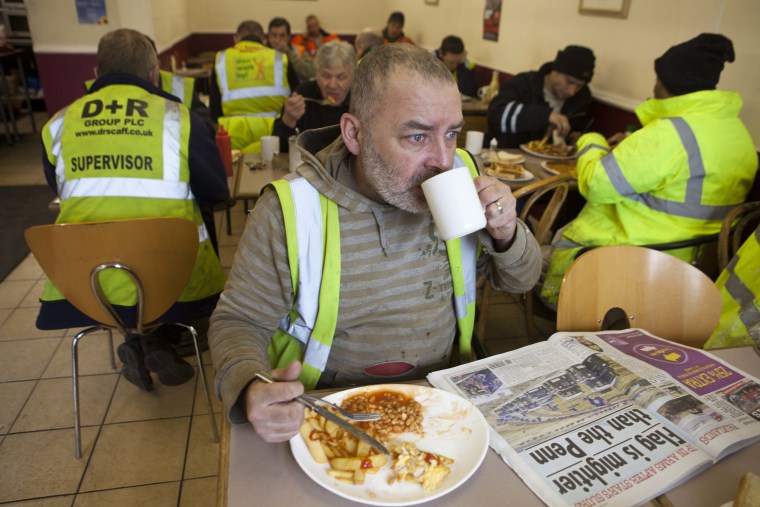
Construction workers take a break from their task of building the Olympic site to enjoy a substantial lunch at The Griddler, a local café very close to site of the games. Because their breaks are so short, often under half an hour, the chef tries to get their food to them within five minutes of placing the order. The owners of the café, Frank and Rosie Aviatti, are popular local characters who strongly resent the impact of the Olympic construction on their business and their community.
“We was doing all right until the Olympics come along,” Frank says. A few years ago part of the road that the café is on was shut down for Olympics-related construction projects and “business went down 90 percent,” he says. They considered shutting it down but powered through, buoyed slightly by the business that construction workers brought them. “My problem now is that I’ve been talking to the workers, and they’ve only got another month-and-a-half,” he says. “What are we left with? Shambles.”
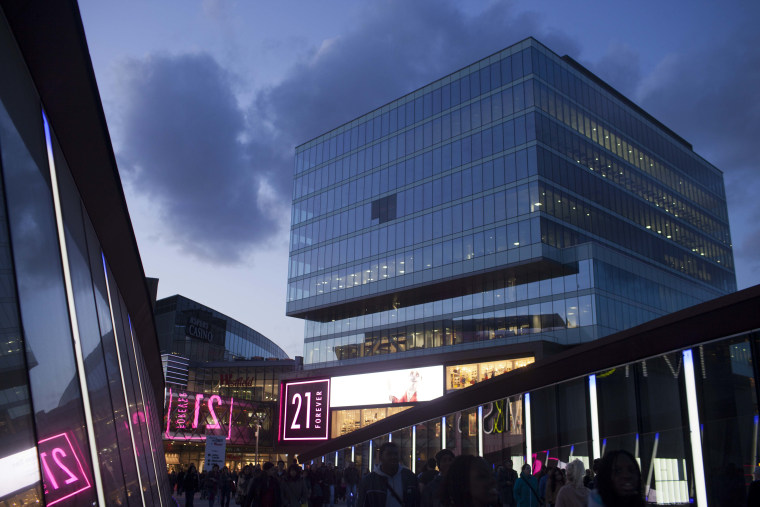
A view of the entrance to the new Westfield Stratford City shopping center, which houses 236 stores and 50 cafes and restaurants. There has been much controversy about the fact that around 70 percent of spectators attending the games will have to walk through its courtyard to enter the Olympic park.
Jean Jeffrey, commercial officer for Newham Council, hails it as an example of how much the Olympics has regenerated the borough, and points out that it has brought jobs to the area. “The Olympics coming to Newham is a bonus,” she says. “If you think about it, because of the global financial crisis and the economic downturn, we wouldn’t have had that shopping center built and opened now.”
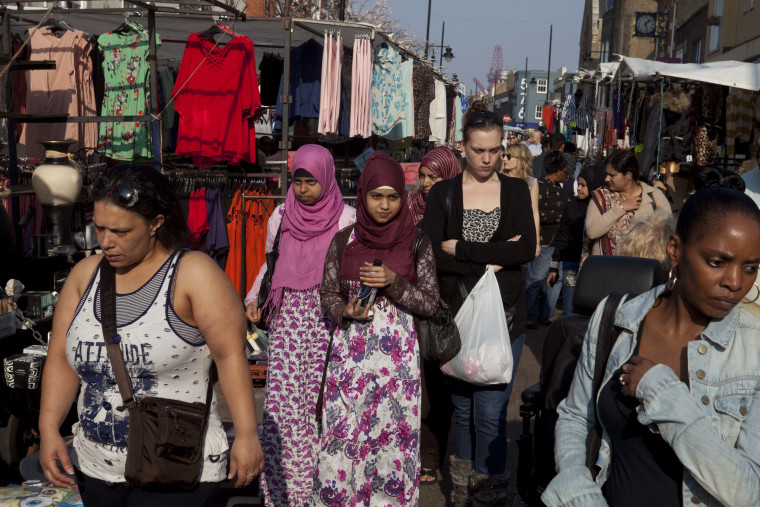
A busy Saturday afternoon scene at the Roman Road Market in Tower Hamlets, very close to the Olympic park. In the background the top of the ArcelorMittal Orbit tower at the center of the site can be seen. This area, which was traditionally a white working class East End community, now has a large Bengali population.
Story: Olympic housing crunch: London landlords evict tenants to gouge tourists
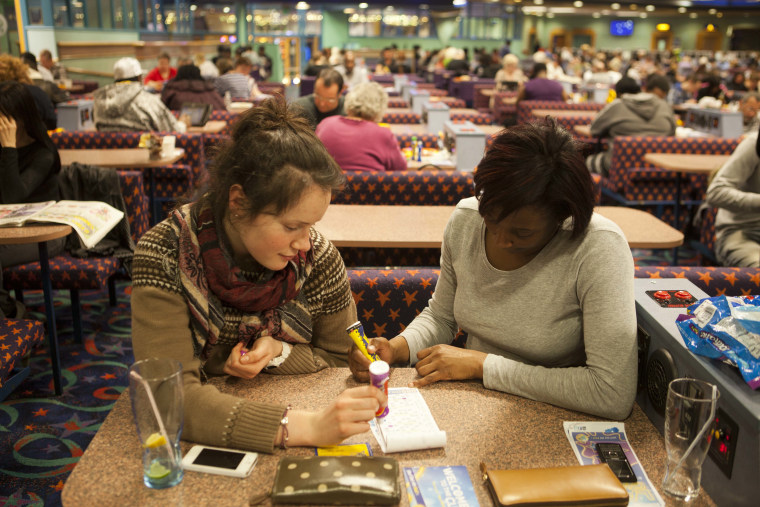
“We get all kinds of cultures, ethnic origins … It’s one of few places you can go where you can get all that, where they can socialize together – and it works,” says Larry Elliot, an operations manager at the Gala Bingo club in Stratford, shown here. Older people come in the afternoons to enjoy other people’s company and younger visitors tend to come in the evening, Elliot says. While the regeneration projects brought on by the Olympics have been “brilliant” there are mixed feelings, he says. The club worries that people might have trouble getting there on packed buses and trains this summer.
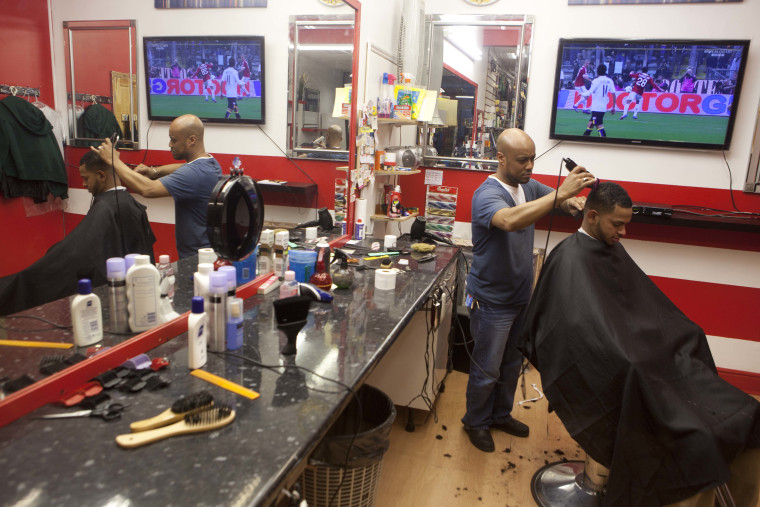
A barber cuts a man’s hair in a barbershop on Leyton High Road, close to the main site of the Olympic Games. The barber who owns the shop, Abdul Mimum Abdullah, shown here, is a refugee from Somalia and has been in London for 20 years. He says he moved to East London in particular because of the huge Somali community there. “You feel like you are back home,” he says, explaining that there are 10 Somali restaurants on his road alone. His patrons, many of whom are Somali like himself, often come in just to talk, watch soccer or have a drink – he often stays open until 10 p.m.
Many of the younger “troublemakers” in the neighborhood are now employed at the new Westfield shopping center or are cleaning streets in the area, Abdullah says. “Some of them cooled down because they gave them jobs,” he says. “Now they’re cool.”
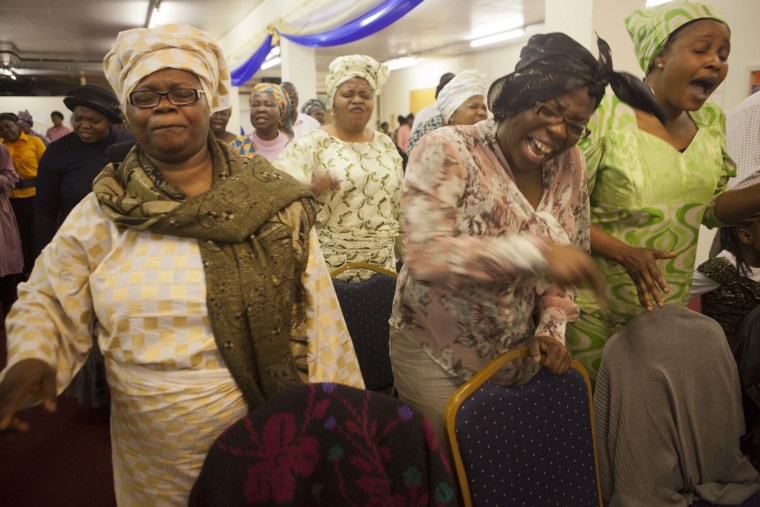
A moment of intense prayer at the Mountain of Fire and Miracles Ministries Church in Hackney Wick. This Pentecostal church, which has modest beginnings in Nigeria, has now grown to have international branches in many cities around the world, with London being the first. In the UK alone, the Mountain of Fire and Miracles Ministries has 75 branches. The majority of people attending the services are originally from Nigeria.
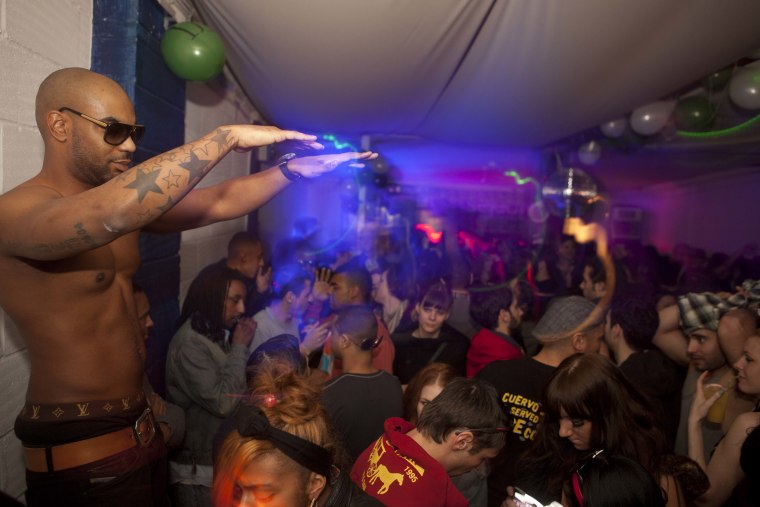
Dancers enjoy a long night of electronic house music put on by event company Select Elect at a warehouse complex directly across the River Lee from the main Olympic site. Revelers buy tickets to Select Elect parties online and then organizers send out details of the location the day before – the parties are held in old warehouses, basements and other “secret” venues. “[People] engage with us because they want to know what they bought their tickets for,” says Robert Zweiniger, one of the company’s promoters.
Zweiniger doubts the Olympic crowds will be attracted to this kind of event – “they will be into a more commercial scene,” he says – but the games will still have a marked long-term effect. “Underground raves and parties might have a problem with sustainability if everything is being rebuilt,” Zweiniger says, worrying about potential party venues disappearing. “Subcultural movements might get lost and move.”
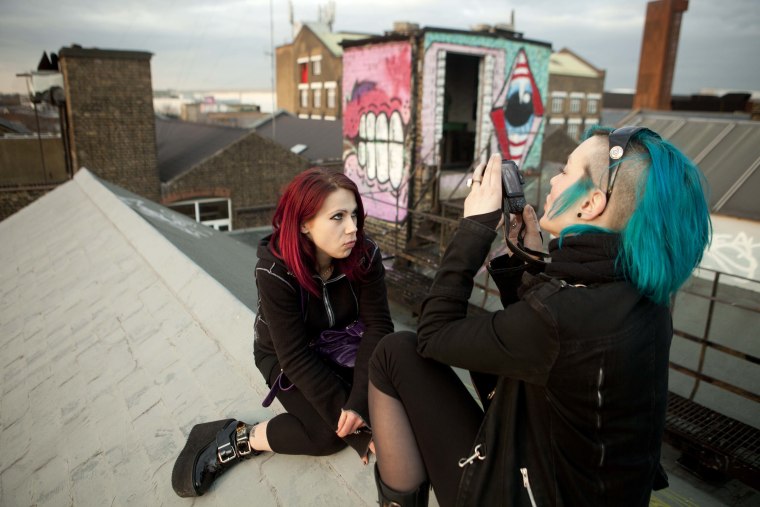
Two young artists and models who live in an old industrial building overlooking the Olympics site pose for photographs. Their building has been converted into live/work studios so many creative people in the arts and music scene live there. The rooftop also has some noticeable and vibrant graffiti by an anonymous artist known as Sweet Toof, whose work keeps popping up in various shapes and sizes around the sites of the 2012 Olympics.
Graphic designer James Brown, whose studio is in an old peanut factory building, says this part of East London used to feel “like the end of the world,” but now it is more accessible to people. So much has changed recently that in some cases, “I can’t remember what was there before,” he says.
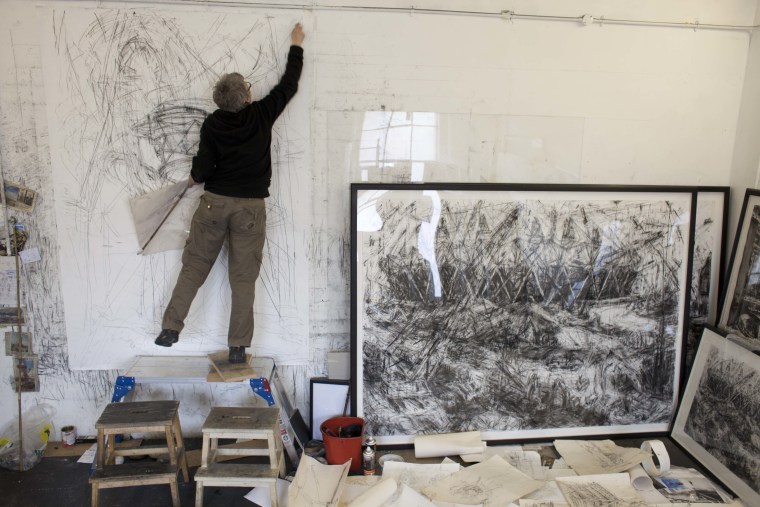
Artist Jeannette Barnes works in her Hackney Wick studio near the Olympic stadium. She is one of a large community of artists who work in the old industrial buildings in the area, and is one of the rare supporters of the development brought on by the games. She says there are parts of the neighborhood she wouldn’t have dared walk through for fear of her safety before the building started. “I would have got mugged,” she says.
Many of Barnes’ recent works depict the construction around the Olympic sites – in this picture she is working on a charcoal drawing of the ArcelorMittal Orbit tower, the controversial sculpture by Amish Kapoor at the center of the site. “I love it,” she says, shrugging off others’ criticism. “It’s a lovely, complicated interesting thing.” The framed work alongside shows the construction of the Olympic stadium.
Hackney Wick has one of the highest concentrations of art studios in the world, according to the local artists, and many of them resent the Olympics’ intrusion into their lives. “There are thousands of art studios already, and really cheap housing, so [new buildings] feel like competition,” says Rebecca Whyte, who runs the Stour Space studio and gallery – the closest public building to the Olympic stadium. She fears artists will be priced out of their studios and worries that the unique community will be lost. “In a big, huge, international project like this, the little guy never wins,” she says.
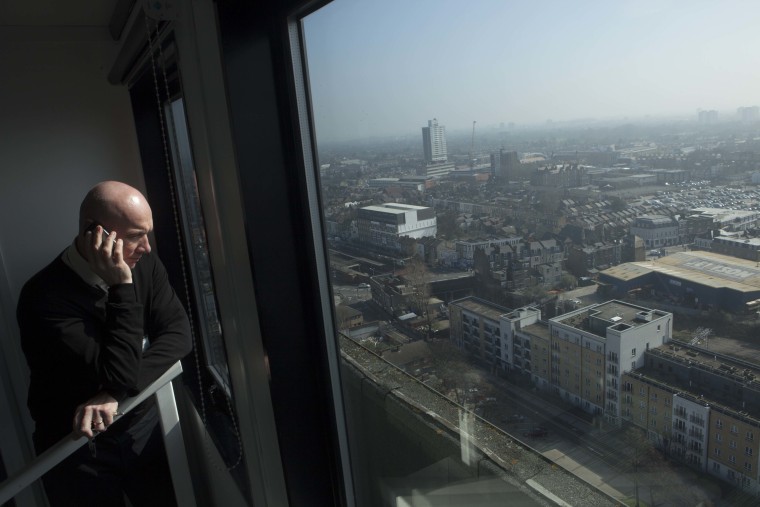
A member of the Hertfordshire County Council talks on his phone after hearing a presentation in a viewing platform in a building overlooking the site of the 2012 Olympic games. He is looking out over the borough of Newham, London’s poorest. Roughly a quarter of households live in poverty and the employment rate is 55.3 percent, the lowest in the country, according to statistics from the council.
“We’ve had nothing in our borough for a long time,” Jean Jeffries, the Newham Council officer, says. But with the Olympics in town she is hopeful that those numbers will turn around. “We’re going to give West London a run for their money in time,” she says.
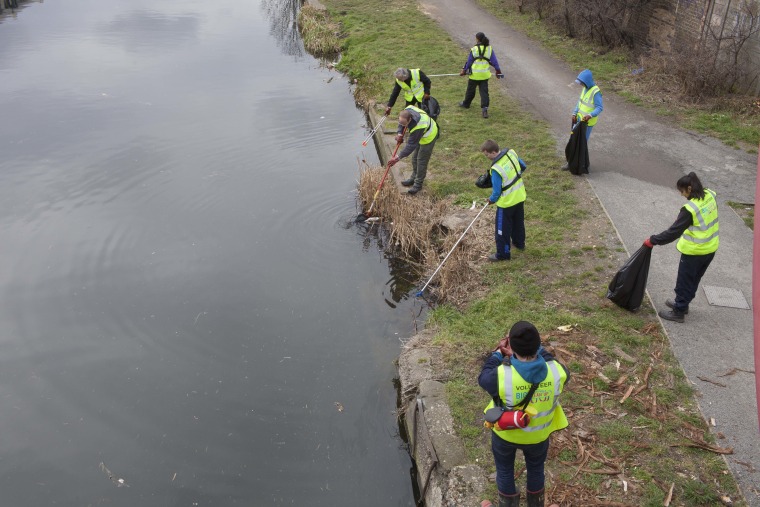
A group of volunteers cleans the banks of the River Lee, close to the site of the 2012 Olympic games. They are mostly teenagers and are taking part in the Big Waterways Clean Up 2012 campaign, a partnership campaign to improve East London’s waterways.
British Waterways is also working with the Metropolitan Police and the London 2012 Organising Committee (LOCOG) to improve security and the environment, and facilitate a clean water supply for the greater number of people mooring their houseboats around London. Dredging will clean and deepen the channels, says Fran Read, the British Waterways spokeswoman. “We want to keep the waterways navigable for boats,” Read says, explaining that there will be higher traffic along the rivers and canals from both security vessels and passenger boats.
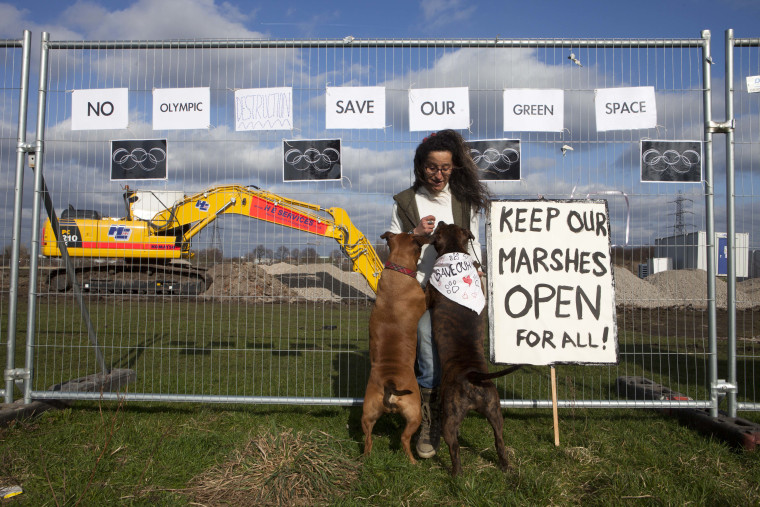
“They say this is the green lung of London. Well it’s not really green right now, is it?” says Vicky Sholand, a Leyton Marsh resident and dog-walker. She and a group of locals have been protesting the Olympic Delivery Authority’s (ODA) construction of a temporary basketball training court on an area of natural parkland, shown here. Sholand says most residents didn’t know what was happening until the fence went up to block off the site for construction. “They put up notices on small pieces of paper but most people didn’t see them,” she says.
The ODA won the right to build despite a petition signed by more than 1,250 local people. It promised the construction would only dig 15 centimeters (6 inches) into the ground and said the green space would be returned to its natural condition after the games. This is disputed by the Save Leyton Marsh group, which claims it is a land grab by the Olympic authorities and believe there will be long-term damage to the site.
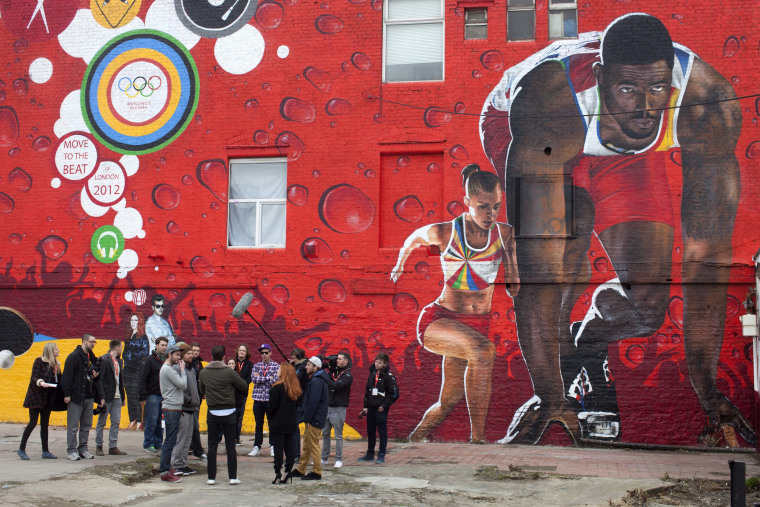
Members of the press, Coca-Cola sponsors, music producer Mark Ronson and pop singer Katy B gather for a media event as part of the company’s London 2012 sponsorship campaign, “Move to the Beat,” in the shadow of the Olympic stadium. Ronson and Katy B collaborated to produce Coca-Cola’s “Anywhere in the World” anthem, which Coca-Cola says fuses the sounds of Olympic sports with the beat of London music.
The “Beat Wall” artwork, by photorealist artists Neil Edward, Hadley Ever and Same Bates, represents how Ronson gained inspiration from young athletes for the song. Shortly after the filming of the media event the wall was painted over.
On Aug. 12, a colorful and vibrant East London will say farewell to thousands of athletes, coaches, officials and visitors at the Olympic closing ceremony.
Photographer: A world of athletes is coming to a neighborhood with a world of diversity